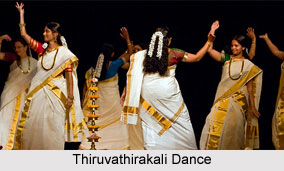 Thiruvathirakali dance is a kind of Indian dance practised during the festival Thiruvathira in the southern Indian states of Tamil Nadu and Kerala during the full moon day, in `Dhanu` month, as per `Tamil Margazhi` which falls during the middle of December and continues till middle of January. This particular dance form is connected to Lord Shiva and is held in the annual festival of Sri Nataraj Temple known as `Uthsav` in Chidambaram, Tamil Nadu. According to some stone inscriptions and historical evidences, this dance form is said to have emerged above 1500 years ago. During this festival, the idols of Lord Shiva as Nataraj and his consort Parvati or `Shivagami` are taken outside the temple premises, into a large procession. Originally, the Tiruvathira celebration must have begun as a simple folk song and dance, but later narrative poems having classical quality were written specially for such dances.
Thiruvathirakali dance is a kind of Indian dance practised during the festival Thiruvathira in the southern Indian states of Tamil Nadu and Kerala during the full moon day, in `Dhanu` month, as per `Tamil Margazhi` which falls during the middle of December and continues till middle of January. This particular dance form is connected to Lord Shiva and is held in the annual festival of Sri Nataraj Temple known as `Uthsav` in Chidambaram, Tamil Nadu. According to some stone inscriptions and historical evidences, this dance form is said to have emerged above 1500 years ago. During this festival, the idols of Lord Shiva as Nataraj and his consort Parvati or `Shivagami` are taken outside the temple premises, into a large procession. Originally, the Tiruvathira celebration must have begun as a simple folk song and dance, but later narrative poems having classical quality were written specially for such dances.
Mythological History of Thiruvathirakali Dance
The dance of Thiruvathirakali is said to signify marital bliss and female energy, which is believed to have restored the life of Lord Kama Deva, who was reduced to ashes, due to the fury of Lord Shiva. As per some mythological accounts, this form of dance was performed to honour Lord Shiva, whose consort was Parvati.
Performance of Thiruvathirakali Dance
The Thiruvathirakali dance is practised by the regional womenfolk of Tamil Nadu and Kerala. The `Thiruvathira Pattu` accompanies this special dance. The folk songs which are sung along with this dance depict the penance of Parvati, who pines for the affection and might of Lord Shiva. The dancers sway rhythmically to sinuous movements in a circular pattern, around a `nilavilakhu` (a ceremonial lamp) and this style of dance is referred to as the `Lasya`, which is a feminine dance. While the dance is being performed, the dancers clap and sing.
This is a dance where the maidens revolve their steps, while standing in a circle and then their palms alternately meets the next girl dancing in rhythmic claps. The dancers also sing a narrative song as they move forward, but in circles. Currently, the Thiruvathirakali dance is performed in several social occasions and is quite popular. The dance is generally performed on special festivals like Onam. Women perform this dance in a group, clad in traditional saris, their hair buns adorned with fresh Jasmine flowers. `Mundu neriyathu` is the costume which is worn by them during this dance.
The cultural level has always been fairly high in Kerala and both the middle as well as the upper classes of women fully participates in this favourite folk dance form.



















